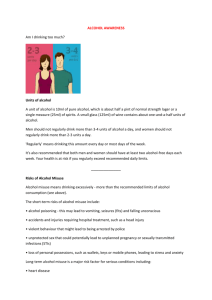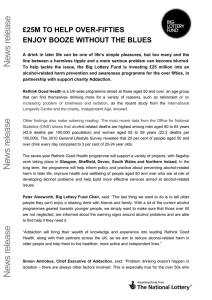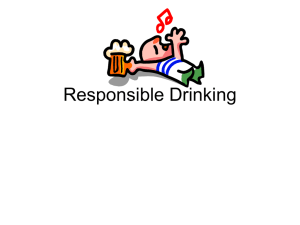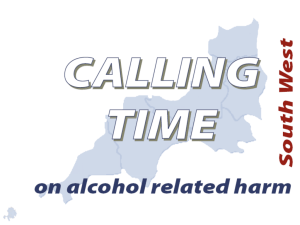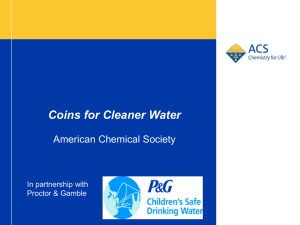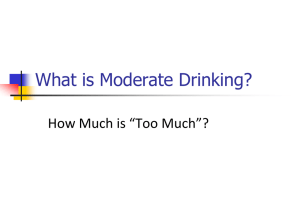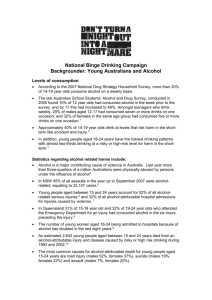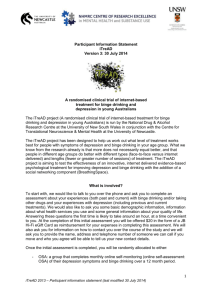Alcohol Misuse In Older Adults
advertisement
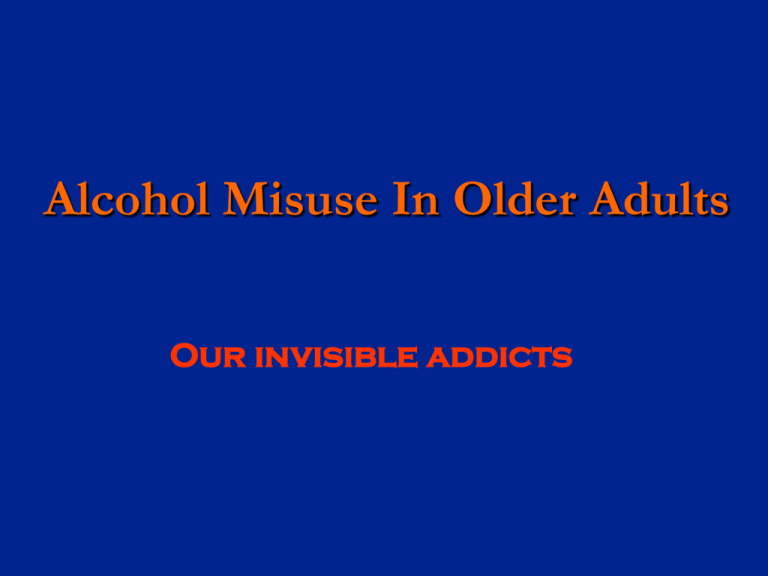
Alcohol Misuse In Older Adults Our invisible addicts EUROPEAN DISEASE BURDEN ATTRIBUTABLE TO SELECTED LEADING RISK FACTORS (2000) Blood pressure Tobacco Alcohol Cholesterol High Body Mass Index Fruit and vegetable intake Physical inactivity Illicit drugs 0 5000 10000 15000 20000 Number of Disability-Adjusted Life Years (000s) ‘SENSIBLE LIMITS’ (‘HAZARDOUS/HARMFUL’) (Royal Colleges 1995) >21 Units per week (men) & >14 per week (women) 1990 % of men 65+ % of women 65+ 2009 14 20 5 10 (Office of National Statistics) ALCOHOL DEPENDENCE SYNDROME Fewer than 5% of community residents 15% of older medical in-patients 42% of older homeless men Alcohol-related mortality in men - London (Office of National Statistics) 1991-1997 Men aged 75+ 21.7/100,000 1998-2004 25.7/100,000 Alcohol-related mortality in men - Southwark (Office of National Statistics) 2008-2010 Men aged 75+ 64.9/100,000 LOCAL CMHT DATA Prospective study of CMHT referrals from Jan - Dec 02 1 in 7 people with depression had alcohol dependence OBSERVATIONS IN PEOPLE DRINKING ABOVE ‘SENSIBLE’ LIMITS • 43% showed ICD ‘alcohol dependence syndrome’ • 21% showed ‘harmful use of alcohol’ • 71% had suffered physical problems • 57% admitted to MH Ward or presented to A&E PEOPLE AGED 65 AND OVER PROJECTED POPULATION OF ENGLAND 2001-2031 25 22 20 19 17 16 15 2001 2011 2021 2031 12 10.2 10 8.6 7.8 5 0 Population of England (million) % of Total Gender differences in older people Women with alcohol misuse more likely to: Be widowed/separated/divorced Have spouse with alcohol misuse Have history of depression More negative effects from alcohol Take psychotropic medication Characteristics of early vs late-onset problem drinkers Early onset (65%) Late onset (35%) Age varies (<25, 40, 45) Age varies (>55, 60, 65) Men > women Women > men Lower socioeconomic statusHigher socioeconomic status Stressors common Stressors common Family History likely Family History unlikely Legal/Work problems Problems with daily routine Chronic medical illness Acute medical illness Amnestic Syndrome Alcohol-related dementia Less treatment compliance Greater treatment compliance Alcohol interactions in older adults Warfarin Antihistamines Benzodiazepines Aspirin Acid reducing drugs Opiate containing painkillers Antibiotics Drugs for diabetes Paracetamol Alcohol and the body- consequences for older people Decreased lean body mass Decreased total body water Decreased level of liver enzyme that breaks down alcohol Higher blood alcohol concentration than younger people, for given number of units Effect of physical health status Threshold for ‘at risk’ use decreases with age Higher risk of other diseases (e.g. hypertension, diabetes, dementia) Body sway increases with ‘sensible drinking’ and normal blood alcohol level Activities of daily living and alcohol misuse Shopping Using public transport/driving Taking medication Cooking Other housework Managing finances Drinking > 8 units per week associated with impairment in domestic activities Chronic Alcohol Use Cognitive disorders CVA Psychosis Depression Neuropathy Anaemia Nutritional Deficiencies Liver Disease Cirrhosis Pancreatitis Diabetes Head, Neck, GI cancers Coronary Artery Disease Cardiomyopathy Arrhythmia Hypertension Stroke Stomach ulcer Gastritis Duodenal ulcer NORMAL BRAIN WERNICKE’S ENCEPHALOPATHY HIGH RISK GROUPS • Homelessness • Past harmful/hazardous drinking • Recent bereavement • Depression • Social isolation • Retirement • Immobility BARRIERS TO IDENTIFICATION AND TREATMENT I AGEISM ‘It’s all he/she has in life’ ‘Always been a poor sleeper’ ‘Can be a bit fussy with food’ Care of the Elderly physicians less likely than general physicians to screen for alcohol use UNDER-REPORTING Seen as a moral weakness Stigmatising BARRIERS TO IDENTIFICATION AND TREATMENT II MIS-ATTRIBUTION Identifying alcohol-related symptoms as physical illness/ depression/cognitive impairment STEREOTYPING Poorer detection of drinking in: Women Higher levels of education Higher social class Widows MENTAL DISORDER SUICIDE DRUG INTERACTIONS ALCOHOL ELDER ABUSE PHYSICAL DISORDERS ACCIDENTS (FALLS) SELF NEGLECT RATING SCALES Commonly not used in primary AND secondary care, because of • Time constraints/competing demands • Insufficient Training • Limited evidence for treatment ‘Traditional Rating Scales’ lack sensitivity and validity, particularly in the elderly Alcohol Screening For Older Adults (SMAST-G) 1. Underestimates amount of alcohol 2. Misses meals 3. Uses alcohol to decrease tremors 4. 5. 6. 7. Memory blackouts after drinking alcohol Drinking to relax/calm nerves Drinking to take mind off problems Drinking after significant loss 8. Concern about drinking from doctor/nurse 9. Making rules to manage drinking 10.Drinking to ease loneliness IMPLICATIONS FOR EXISTING SERVICES Extrapolating prevalence data for people aged 65 and above: OVER 500 men and 300 women in both Lewisham and Southwark with a diagnosis of Alcohol Dependence Syndrome Recommendations from Our Invisible Addicts Improved detection by primary and secondary care Improved access to treatment Improved training of health professionals Better partnerships between statutory and voluntary sectors Better provision, e.g. for alcohol related brain injury Prioritisation in government policy Prioritisation for research into extent of problem, detection, treatment and health/social care outcomes
